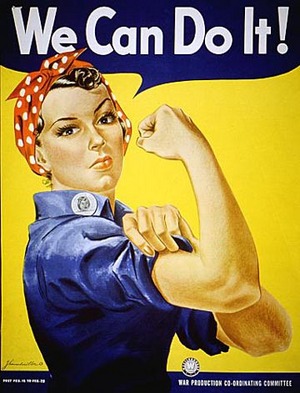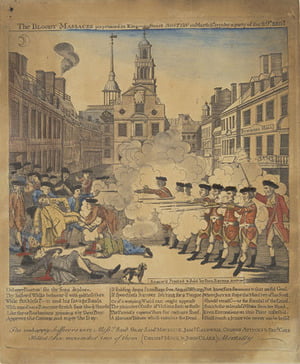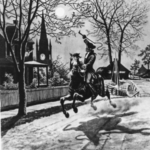The Boston Massacre was an infamous incident that occurred in Boston just before the American Revolution. The date was March 5, 1770. It was a skirmish between seven British regulars and a mob of citizens, which resulted in the deaths of five men. It was by no means a massacre, but the name that it came to be known as is indicative of the propaganda used by rebels to incite anger against the British. Nevertheless, having one ‘foreign’ soldier for every four citizens in your town is enough to make any American angry.
The disagreement that led to the Boston Massacre began when Edward Garrick insulted a regular named Hugh White. Hugh hit the young barber’s assistant with his rifle and knocked him down. Edward left the scene and spread the word about the attack. He soon came back to the scene with a group of citizens comprised mostly of boys. Upon his return, he reportedly pointed at Hugh and said, “There’s the son of a bitch that knocked me down.” The crowd of boys was soon joined by a group of adults. The mob eventually numbered around 400.
The civilians involved in the Boston Massacre were not innocent of wrongdoing. Sure, they had a reason to be angry that a soldier had struck a boy. However, the civilians began taunting Hugh and the six other soldiers that appeared to back him up. They threw ice, snow, stones and a couple of them reportedly attacked the soldiers with clubs and a cutlass. Furthermore, they repeatedly dared the regulars to shoot them.
The regulars who were present at the Boston Massacre only fired after they had been attacked. Certainly, they were an unwelcome lot and Hugh White had instigated the situation by not having the presence of mind to ignore the taunts of a young boy. However, the civilians were undeniably looking for trouble. Both sides were provoked and both sides did the provoking. This is one of the reasons the Boston Massacre was not a massacre.
A little more than a week before the Boston Massacre, a young man (aged 12 or younger) named Christopher Seider had been shot and killed in Boston by a loyalist. This incident had raised the tension in Boston, which may have contributed to the events on May 5. It certainly did not help.
The Boston Massacre resulted in the temporary removal all of British troops from the town of Boston. They were sent to Castle Island in the Boston Harbor to prevent further incident.
Captain Thomas Preston was the commanding officer in the group of regulars. The men should not have fired without his orders. However, it appears they did. Furthermore, there was an order in place at the time that regulars could not discharge their weapons in Boston without the permission of a civil magistrate. They did not have this, either. Nonetheless, it appears that someone said “Fire!” that day. Therefore, the regulars believed that they were acting on orders. The ‘order’ may have come from the mob or from one of the soldiers (not Preston).
The Boston Massacre was just the fuel that Boston patriots needed for their rebellious fire. While Crispus Attucks (the most famous victim of the Boston Massacre) and one other victim lay dead at Faneuil Hall, men like Samuel Adams demanded the removal of troops from Boston. Somewhat surprisingly, John Adams was the man who defended the regulars involved. He managed to save them all from the death penalty. It did not hurt his career.
Sources
Detailed Description, retrieved 4/15/10, bostonmassacre.net/plot/detailed2.htm
Boston Massacre, retrieved 4/15/10, u-s-history.com/pages/hb44.html



